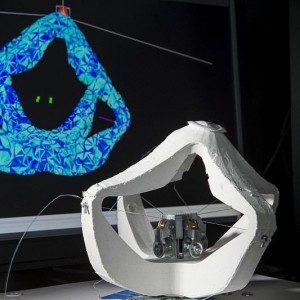 The Software
The Software
Our contribution consists in a new framework to simulate and control soft robots [Duriez et al. 2016]. This framework is based on a mechanical modeling of the robot elements combined with fast real-time direct/inverse FEM solvers. The keypoint of our approach is that the same modeling is used for interactive simulation of its behavior and interactive control of the fabricated robots. The simulation framework also allows to model the robot’s environment and their interactions. The theoretical aspects of our contribution are presented in the following papers [Duriez et al. 2016], [Coevoet et al. 2017a], while its implementation is done in the plugin SoftRobots for the SOFA Framework (www.sofa-framework.org/).
Our scientific contribution is the modeling of the mechanical behavior of the robots (material and geometry) as well as how they are actuated. With this mechanical model, it becomes possible to compute the position of the robot according to changes on the inputs of the actuators (pressure, displacement). We can also simulate the mechanical interaction of the robot with its environment. One of the central features of the approach is the use of inverse formulation of the simulated model: it is possible to control the robots by their end-effector position letting the system compute the changes to apply on the inputs of the actuators. The modeling and algorithmic formulations are detailed in [Duriez et al. 2016] and [Coevoet et al. 2017a].
Our approach can handle all types of geometry. If the 3D mesh model exceeds a range of around 2200 vertices, we advise to use the ModelOrderReduction plugin to avoid computational burden concerns.
Current limitations and Future work
There are some limitations of our approach:
- The deformable model used in the examples is a non-linear geometric model under linear elasticity assumption (restricted to deformations in the linear part of the stress-strain curve of the material, ie. small deformations but large transformations). For a more accurate model of the mechanical behavior of the deformable material ie. a mechanically accurate deformation law, large deformations should be handled. Our current implementation doesn’t consider hyperelasticity yet (which is more computationally intensive). We currently work on adapting the fast hyper elastic formulations recently available in SOFA to our control method to overcome this limitation.
- Our SoftRobots plugin proposes the following actuators: tendon-driven, pneumatic actuators, soft part attached to rigid joints. We plan to add the hydraulic actuation by considering a combination of the pressure action (present in pneumatic actuators) and the simultaneous effect of the liquid’s weight [Rodrìguez et al. 2017]. We also aim at modeling more complex types of actuation found in current soft robots such as: electroactive polymers and shape-memory alloys.
- Finally, while direct simulation of the robot (from forces to displacements) can handle friction contacts (as shown in the grasping part of the tutorial), the inclusion of friction in the inverse simulation (from desired displacements to required forces) is still a work in progress with major challenges in the optimization problem. Yet, our SoftRobots plugin proposes a real-time control of soft robots interacting with their environment or with self-collision regions without friction [Coevoet et al. 2017b].
Please note that this contribution is protected by an international patent [Duriez 2013b]. The free access to the software is limited to educational classroom and research purposes (academic licence). It cannot be used for any commercial purpose without acquiring a separate license or otherwise getting an authorization from INRIA.
References
[Duriez 2013a] Christian Duriez.
Control of Elastic Soft Robots based on Real-Time Finite Element Method,
ICRA 2013. (https://hal.inria.fr/hal-00823766)
[Duriez 2013b] Christian Duriez.
Method for controlling a deformable robot, and related module and computer program,
WO2014122134 A1
[Faure et al. 2012] François Faure, Christian Duriez, Hervé Delingette, Jérémie Allard, Benjamin Gilles, et al.
SOFA: A Multi-Model Framework for Interactive Physical Simulation.
Yohan Payan. Soft Tissue Biomechanical Modeling for Computer Assisted Surgery, 11, Springer, pp.283-321, 2012, Studies in Mechanobiology, Tissue Engineering and Biomaterials, 978-3-642-29013-8. (https://hal.inria.fr/hal-00681539)
[Rodrìguez et al. 2017] A. Rodrìguez, E. Coevoet, and C. Duriez.
Real-tome simulation of hydraulic components for interactive control,
ICRA, 2017. (https://hal.inria.fr/hal-01535810)
[Duriez et al. 2016] Christian Duriez, Eulalie Coevoet, Frederick Largilliere, Thor Bieze, Zhongkai Zhang, et al.
Framework for online simulation of soft robots with optimization-based inverse model,
SIMPAR, 2016. (https://hal.inria.fr/hal-01425349)
[Coevoet et al. 2017a] Eulalie Coevoet, Thor Bieze, Frederick Largilliere, Zhongkai Zhang, et al..
Software toolkit for modeling, simulation and control of soft robots,
Advanced Robotics, 2017. (https://hal.inria.fr/hal-01649355)
[Coevoet et al. 2017b] Eulalie Coevoet, Adrien Escande, and Christian Duriez,
Optimization-based inverse model of soft robots with contact handling,
RA-Letter, 2017 (Proc. ICRA). (http://hal.univ-lille3.fr/hal-01500912)



